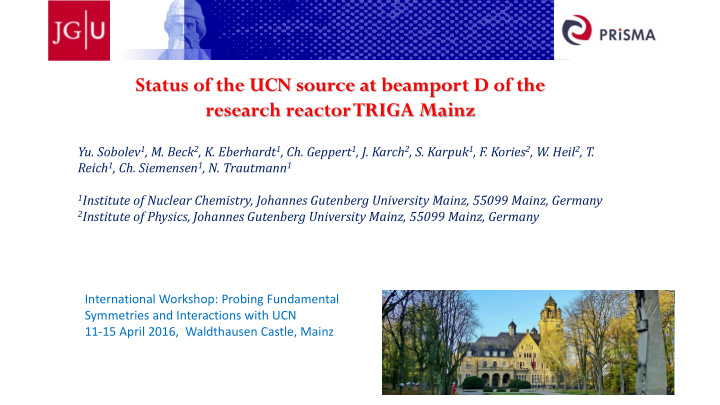



Status of the UCN source at beamport D of the research reactor TRIGA Mainz Yu. Sobolev 1 , M. Beck 2 , K. Eberhardt 1 , Ch. Geppert 1 , J. Karch 2 , S. Karpuk 1 , F. Kories 2 , W. Heil 2 , T. Reich 1 , Ch. Siemensen 1 , N. Trautmann 1 1 Institute of Nuclear Chemistry, Johannes Gutenberg University Mainz, 55099 Mainz, Germany 2 Institute of Physics, Johannes Gutenberg University Mainz, 55099 Mainz, Germany International Workshop: Probing Fundamental Symmetries and Interactions with UCN 11-15 April 2016, Waldthausen Castle, Mainz
Research reactor TRIGA Mainz UCN-D UCN-C two operation modes: steady state: 100 kW th , 10 12 n/cm 2 s pulse mode: 250 MW th (30 ms), 2 10 15 n/cm 2 s
UCN facilities at TRIGA Mainz Reactor TRIGA Mark II Experimental area Experimental area of UCN source of UCN source beamport D He liquefier beamport C Gas system
UCN source at beamport D of the TRIGA Mainz
UCN source at beamport D : brief history 2007-2011 Construction of the gas system and the cryostat of the UCN source May 2011 First yield of UCN at beamport D 2012-2013 Optimization of the heat load for solid deuterium, UCN density measurements 2014 Installation and commissioning of the helium liquefier 2015-2016 Regular operation of UCN source at beamport D
Measurements of UCN source performance Setup Experimental setup used to measure the UCN&VCN source performance: S 1 safety shutter at the exit of the UCN source; V st – storage vessel; fast shutters S 2 and S 3 with opening and closing times of 0.1 s. A vertical guide (90 cm) leads to the Cascade-U detector. UCN density measurements were performed in the storage mode, whereas UCN&VCN yields were measured in flow-through mode (all shutters S 1 -S 3 were open during pulse).
UCN measurements results for setup with electropolished stainless-steel tubes and 1.7 L trap 360000 for setup with glass tubes between shutters S 1 , S 2 and 9.1 L trap 470000 Measured UCN&VCN counts/0.1s in the flow mode UCN density ( ρ ucn ) per reactor pulse (10 MJ) as a versus time after a reactor pulse at t 0 = 0 s. function of the storage time T st of UCN in a volume of The full squares and the open circles represent experimental V st = 9 . 5 L (filling time was set to Δt = 2 . 5 s). data whereas solid lines show fits. MC simulation gives ~ 2.4x10 5 UCN at the experimental area. Karch, J., Sobolev, Yu., Beck, M. et al.: Performance of the solid deuterium ultra-cold neutron source at the pulsed reactor TRIGA Mainz, Eur. Phys. J. A 50 (2014) 78.
Upgrade of the UCN source at beamport D : MC simulations UCN density [cm -3 ] Height [cm] Expected UCN densities (hollow squares) per reactor pulse (10 MJ) in a storage vessel of V st = 9 . 5 L plotted as a function of the storage time T st . The experimental data are also shown in the diagram (full squares). MC simulations (full circles) using 58 NiMo-coated stainless- steel tubes predict a UCN density ( T st → 0) of about 25 / cm 3 . Simulation program for UCN source & storage setup
Upgrade of the UCN source at beamport D: Concept & transmission measurements Scheme for transmission measurements: Electropolished converter cup & thermal bridge, 58 NiMo coated UCN source Test tube for transmission CASCADE-2D measurement Flight-path tube 45° bend Transmission measurements outer tube Inner guide (electropolished), Ra < 90 nm spacer
Conclusions and outlook A new superthermal UCN source at beamport D of the TRIGA Mainz is in regular operation since April 2015. After installation and commissioning of a helium liquefier in 2014, it has been used for long-term experiments. Currently the UCN source can deliver up to 240000 UCN per 10 MJ reactor pulse at the experimental area. UCN density ~ 10 UCN/cm 3 in a 10 L storage vessel has been obtained. From MC simulations we can expect a factor > 2 higher UCN density per reactor pulse by using neutron guides with a better surface quality (smaller surface roughness) and 58 NiMo coating. The upgrade of the UCN source has just been started. Acknowledgements: This work was supported by the DFG under the contract number He 2308/2-1(2-2), by the Rhineland/Palatinate Foundation, project number 961- 386261/993, and by the Cluster of Excellence PRISMA “Precision Physics, Fundamental Interactions and Structure of Matter”, Exc 1098. We thank the reactor staff, workshops of Institute of Nuclear Chemistry and Institute of Physics, Mainz and Th. Lauer for their help.
Recommend
More recommend